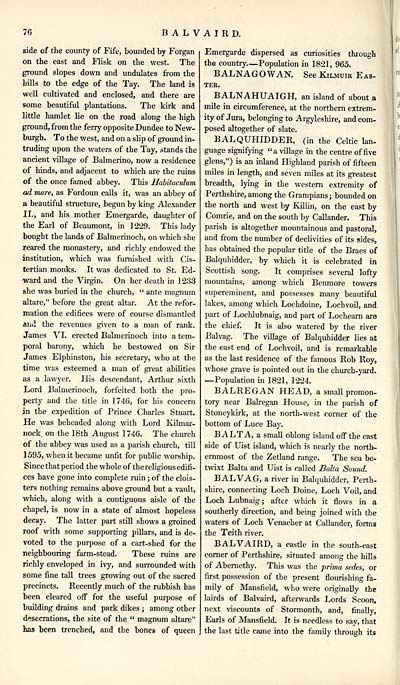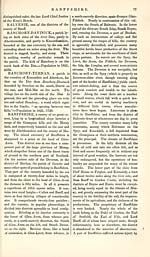Gazetteer of Scotland > Volume 1
(104) Page 76
Download files
Complete book:
Individual page:
Thumbnail gallery: Grid view | List view

76
BALVAIRD.
side of the county of Fife, bounded by Forgan
on the east and Flisk on the west. The
ground slopes down and undulates from the
hills to the edge of the Tay. The land is
well cultivated and enclosed, and there are
some beautiful plantations. The kirk and
little hamlet lie on the road along the high
ground, from the ferry opposite Dundee to New-
burgh. To the west, and on a slip of ground in-
truding upon the waters of the Tay, stands the
ancient village of Balmerino, now a residence
of hinds, and adjacent to which are the ruins
of the once famed abbey. This Habitaculum
ad mare, as Fordoun calls it, was an abbey of
a beautiful structure, begun by king Alexander
II., and his mother Emergarde, daughter of
the Earl of Beaumont, in 1229. This lady
bought the lands of Balmerinoch, on which she
reared the monastery, and richly endowed the
institution, which was furnished with Cis-
tertian monks. It was dedicated to St. Ed-
ward and the Virgin. On her death in 1233
she was buried in the church, " ante magnum
altare," before the great altar. At the refor-
mation the edifices were of course dismantled
and the revenues given to a man of rank.
James VI. erected Balmerinoch into a tem-
poral barony, which he bestowed on Sir
James Elphinston, his secretary, who at the
time was esteemed a man of great abilities
as a lawyer. His descendant, Arthur sixth
Lord Balmerinoch, forfeited both the pro-
perty and the title in 1746, for his concern
in the expedition of Prince Charles Stuart.
He was beheaded along with Lord Kilmar-
nock on the 18th August 1746. The church
of the abbey was used as a parish church, till
1595, when it became unfit for public worship.
Since that period the whole of the religious edifi-
ces have gone into complete ruin ; of the clois-
ters nothing remains above ground but a vault,
which, along with a contiguous aisle of the
chapel, is now in a state of almost hopeless
decay. The latter part still shows a groined
roof with some supporting pillars, and is de-
voted to the purpose of a cart-shed for the
neighbouring farm-stead. These ruins are
richly enveloped in ivy, and surrounded with
some fine tall trees growing out of the sacred
precincts. Recently much of the rubbish has
been cleared off for the useful purpose of
building drains and park dikes ; among other
desecrations, the site of the " magnum altare"
has been trenched, and the bones of queen
Emergarde dispersed as curiosities thiough
the country.-— Population in 1821, 965.
BALNAGOWAN. See Kilmuir Eas-
ter.
BALNAHUAIGH, an island of about a
mile in circumference, at the northern extrem-
ity of Jura, belonging to Argyleshire, and com-
posed altogether of slate.
BALQUHIDDER, (in the Celtic lan-
guage signifying "a village in the centre of five
glens,") is an inland Highland parish of fifteen
miles in length, and seven miles at its greatest
breadth, lying in the western extremity of
Perthshire, among the Grampians; bounded on
the north and west by Killin, on the east by
Comrie, and on the south by Callander. This
parish is altogether mountainous and pastoral,
and from the number of declivities of its sides,
has obtained the popular title of the Braes of
Balquhidder, by which it is celebrated in
Scottish song. It comprises several lofty
mountains, among which Benmore towers
supereminent, and possesses many beautiful
lakes, among which Lochdoine, Lochvoil, and
part of Lochlubnaig, and part of Lochearn are
the chief. It is also watered by the river
Balvag. The village of Balquhidder lies at
the east end of Lochvoil, and is remarkable
as the last residence of the famous Rob Roy,
whose grave is pointed out in the church-yard.
— Population in 1821, 1224.
BALREGAN HEAD, a small promon-
tory near Balregan House, in the parish of
Stoneykirk, at the north-west corner of the
bottom of Luce Bay.
B ALTA, a small oblong island off the east
side of Uist island, which is nearly the north-
ernmost of the Zetland range. The sea be-
twixt Balta and Uist is called Balta Sound.
BALVAG, a river in Balquhidder, Perth-
shire, connecting Loch Doine, Loch Voil, and
Loch Lubnaig; after which it flows in a
southerly direction, and being joined with the
waters of Loch Venacher at Callander, forms
the Teith river.
BALVAIRD, a castle in the south-east
corner of Perthshire, situated among the hills
of Abernethy. This was the prima sedes, or
first possession of the present flourishing fa-
mily of Mansfield, who were originally the
lairds of Balvaird, afteiwards Lords Scoon,
next viscounts of Stormonth, and, finally,
Earls of Mansfield. It is needless to say, that
the last title came into the family through its
BALVAIRD.
side of the county of Fife, bounded by Forgan
on the east and Flisk on the west. The
ground slopes down and undulates from the
hills to the edge of the Tay. The land is
well cultivated and enclosed, and there are
some beautiful plantations. The kirk and
little hamlet lie on the road along the high
ground, from the ferry opposite Dundee to New-
burgh. To the west, and on a slip of ground in-
truding upon the waters of the Tay, stands the
ancient village of Balmerino, now a residence
of hinds, and adjacent to which are the ruins
of the once famed abbey. This Habitaculum
ad mare, as Fordoun calls it, was an abbey of
a beautiful structure, begun by king Alexander
II., and his mother Emergarde, daughter of
the Earl of Beaumont, in 1229. This lady
bought the lands of Balmerinoch, on which she
reared the monastery, and richly endowed the
institution, which was furnished with Cis-
tertian monks. It was dedicated to St. Ed-
ward and the Virgin. On her death in 1233
she was buried in the church, " ante magnum
altare," before the great altar. At the refor-
mation the edifices were of course dismantled
and the revenues given to a man of rank.
James VI. erected Balmerinoch into a tem-
poral barony, which he bestowed on Sir
James Elphinston, his secretary, who at the
time was esteemed a man of great abilities
as a lawyer. His descendant, Arthur sixth
Lord Balmerinoch, forfeited both the pro-
perty and the title in 1746, for his concern
in the expedition of Prince Charles Stuart.
He was beheaded along with Lord Kilmar-
nock on the 18th August 1746. The church
of the abbey was used as a parish church, till
1595, when it became unfit for public worship.
Since that period the whole of the religious edifi-
ces have gone into complete ruin ; of the clois-
ters nothing remains above ground but a vault,
which, along with a contiguous aisle of the
chapel, is now in a state of almost hopeless
decay. The latter part still shows a groined
roof with some supporting pillars, and is de-
voted to the purpose of a cart-shed for the
neighbouring farm-stead. These ruins are
richly enveloped in ivy, and surrounded with
some fine tall trees growing out of the sacred
precincts. Recently much of the rubbish has
been cleared off for the useful purpose of
building drains and park dikes ; among other
desecrations, the site of the " magnum altare"
has been trenched, and the bones of queen
Emergarde dispersed as curiosities thiough
the country.-— Population in 1821, 965.
BALNAGOWAN. See Kilmuir Eas-
ter.
BALNAHUAIGH, an island of about a
mile in circumference, at the northern extrem-
ity of Jura, belonging to Argyleshire, and com-
posed altogether of slate.
BALQUHIDDER, (in the Celtic lan-
guage signifying "a village in the centre of five
glens,") is an inland Highland parish of fifteen
miles in length, and seven miles at its greatest
breadth, lying in the western extremity of
Perthshire, among the Grampians; bounded on
the north and west by Killin, on the east by
Comrie, and on the south by Callander. This
parish is altogether mountainous and pastoral,
and from the number of declivities of its sides,
has obtained the popular title of the Braes of
Balquhidder, by which it is celebrated in
Scottish song. It comprises several lofty
mountains, among which Benmore towers
supereminent, and possesses many beautiful
lakes, among which Lochdoine, Lochvoil, and
part of Lochlubnaig, and part of Lochearn are
the chief. It is also watered by the river
Balvag. The village of Balquhidder lies at
the east end of Lochvoil, and is remarkable
as the last residence of the famous Rob Roy,
whose grave is pointed out in the church-yard.
— Population in 1821, 1224.
BALREGAN HEAD, a small promon-
tory near Balregan House, in the parish of
Stoneykirk, at the north-west corner of the
bottom of Luce Bay.
B ALTA, a small oblong island off the east
side of Uist island, which is nearly the north-
ernmost of the Zetland range. The sea be-
twixt Balta and Uist is called Balta Sound.
BALVAG, a river in Balquhidder, Perth-
shire, connecting Loch Doine, Loch Voil, and
Loch Lubnaig; after which it flows in a
southerly direction, and being joined with the
waters of Loch Venacher at Callander, forms
the Teith river.
BALVAIRD, a castle in the south-east
corner of Perthshire, situated among the hills
of Abernethy. This was the prima sedes, or
first possession of the present flourishing fa-
mily of Mansfield, who were originally the
lairds of Balvaird, afteiwards Lords Scoon,
next viscounts of Stormonth, and, finally,
Earls of Mansfield. It is needless to say, that
the last title came into the family through its
Set display mode to: Large image | Transcription
Images and transcriptions on this page, including medium image downloads, may be used under the Creative Commons Attribution 4.0 International Licence unless otherwise stated. ![]()
| Gazetteers of Scotland, 1803-1901 > Gazetteer of Scotland > Volume 1 > (104) Page 76 |
|---|
| Permanent URL | https://digital.nls.uk/97425610 |
|---|
| Description | Volume I: Abbey to Glenartney. |
|---|---|
| Attribution and copyright: |
|
| Description | By Robert Chambers and William Chambers. Glasgow: Blackie & Son, 1838. 2 volumes. |
|---|---|
| Shelfmark | NF.1461.g.7 |
| Additional NLS resources: | |

